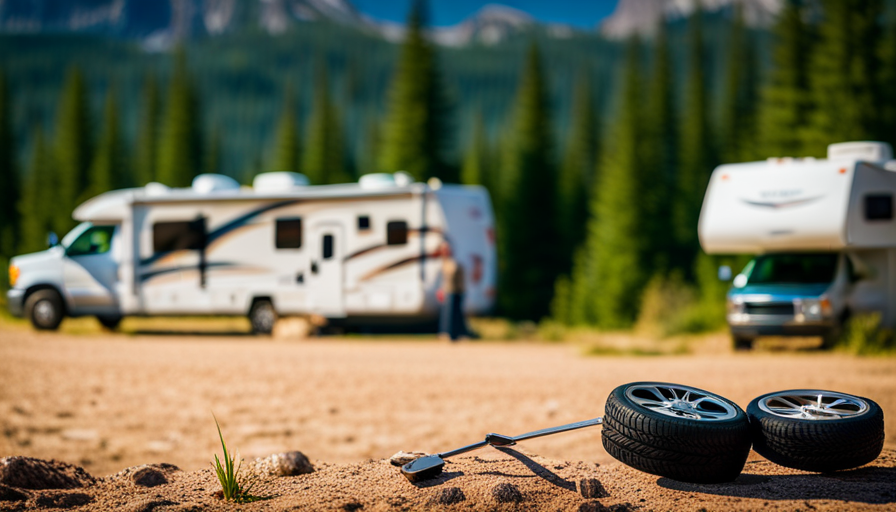Deflating tires can be a daunting task for many RVers, but it is an essential skill to have when traveling on different terrains. Whether you’re driving on sand, mud, or gravel, adjusting your tire pressure can make a significant difference in your RV’s performance and safety.
In this article, we will delve into the world of RV tire pressure and explore two methods for deflating tires safely and efficiently. RVing can be a fun and adventurous experience, but it also requires some basic knowledge and skills. One of these skills is knowing how to adjust your tire pressure to suit different driving conditions.
By deflating your tires, you can increase your RV’s traction, stability, and maneuverability, making your travels smoother and more enjoyable. However, it’s important to note that deflating your tires can also be dangerous if not done correctly. Therefore, in this article, we will not only discuss the methods for deflating tires but also important safety precautions to consider.
So, let’s dive into the world of RV tire pressure and learn how to deflate with ease.
Methods for Deflating Tires
Various methods for deflating tires, including using a screwdriver or specialized tire deflating tool with a bleeder valve, are discussed in the pre-existing knowledge guide on how to let air out of a tire for RVers. These methods are practical and easy to follow, but it is important to note that safety precautions must be taken to avoid accidents.
For instance, tire pressure should be reduced when traveling off-road but not on paved streets. Over-inflating a tire can cause it to explode while on the road, and checking tire pressure may release a minuscule amount of air pressure. It is also important to note that air should not be released from hot tires since it can cause the tires to become dangerous and explode.
Using a screwdriver or key is the easiest method for deflating tires, but it is important to note that the pressure release will happen quickly. Using a specialized tire deflating tool with a bleeder valve is the most accurate method since it allows the user to see the current pressure on the gauge connected to the bleeder valve. Depressing the bleeder valve allows compressed air to escape, and this makes it easy to release the exact amount of air pressure required.
It is important to mention that removing the cap will not reduce air pressure and is not recommended since the tire cap is designed to keep debris out of the tire valve, not to keep air pressure in.
Safety Precautions
When reducing tire pressure for off-road travel, it is crucial to exercise caution as over-inflation can cause a tire to explode, a danger that is heightened when the tires are heated from prolonged use. This can be avoided by regularly monitoring and adjusting tire pressure, as well as avoiding the release of air from hot tires.
It is recommended that tire pressure be reduced when traveling off-road, but not on paved streets, as over-deflation can cause the tire to lose shape and stability, leading to reduced control and increased risk of accidents.
The National Highway Traffic Safety Administration reports that tire-related crashes resulted in 738 fatalities in the United States alone in 2017. This highlights the importance of properly maintaining and monitoring tire pressure, as well as following safe deflation practices.
When deflating tires, it is important to avoid using the tire cap as a means of reducing air pressure, as this will not work and can cause damage to the valve. Instead, a specialized tire deflating tool with a bleeder valve is the most accurate method and allows for easy monitoring of the current pressure.
By following these precautions, RVers can safely and efficiently reduce tire pressure for off-road travel.
Other Helpful Information
Additionally, the article provides helpful information on the importance of monitoring and adjusting tire pressure regularly, as well as the potential dangers of overheated tires and over-deflation. Regular monitoring of tire pressure is essential to ensure optimal tire performance and longevity. It is recommended to check tire pressure at least once a month and before any long road trips. Proper tire pressure can also improve fuel efficiency and handling, while reducing the risk of blowouts.
Overheated tires can be extremely dangerous and can lead to blowouts. It is important to avoid driving on underinflated tires, especially in hot weather. Over-deflation can also be dangerous as it can make the tires more susceptible to damage, reduce the tire’s load-carrying capacity, and increase the risk of a blowout. It is crucial to maintain the manufacturer’s recommended tire pressure and not to deviate from this. In case of any doubts or concerns, it is always best to consult a professional mechanic or tire specialist.
| Tire Pressure | Handling | Wear |
|---|---|---|
| Underinflated | Poor | Outer Edges |
| Overinflated | Poor | Center |
| Properly Inflated | Optimal | Even |

